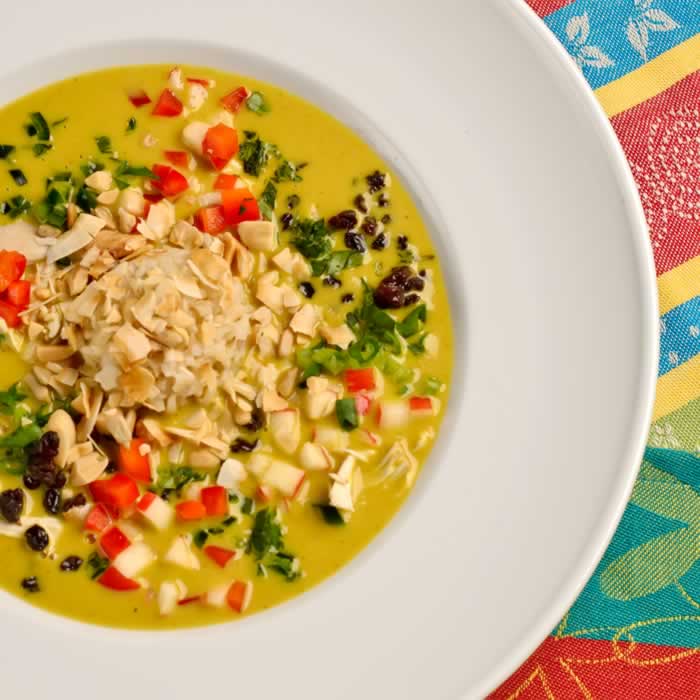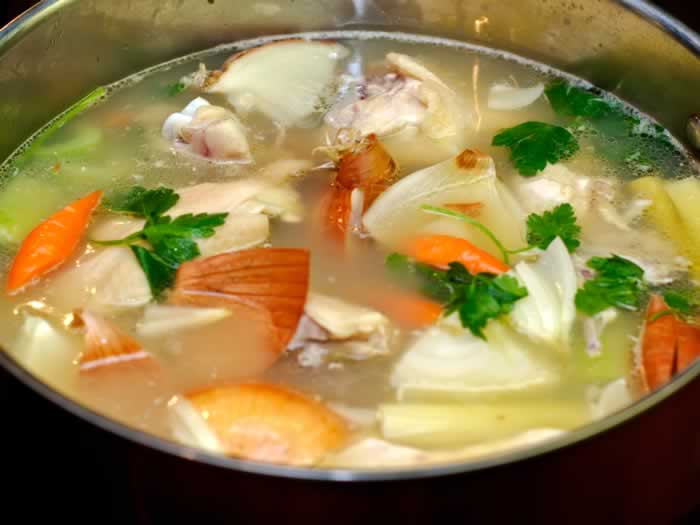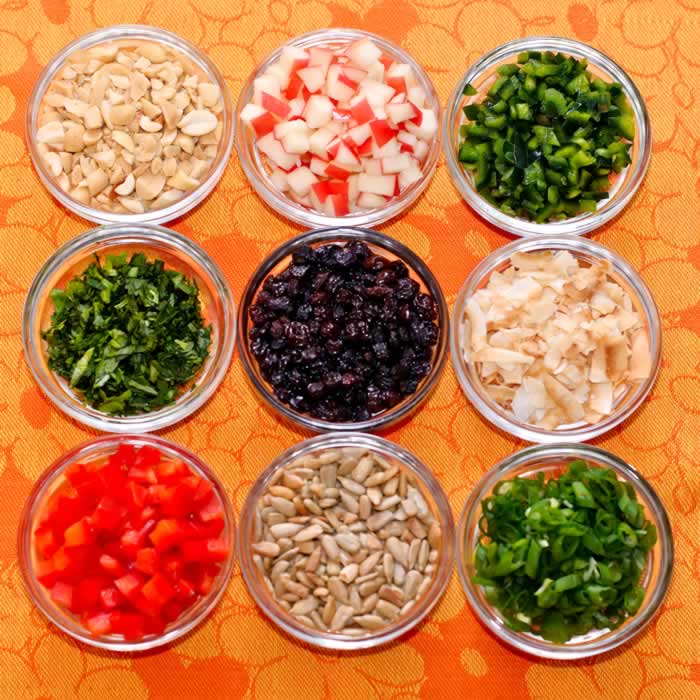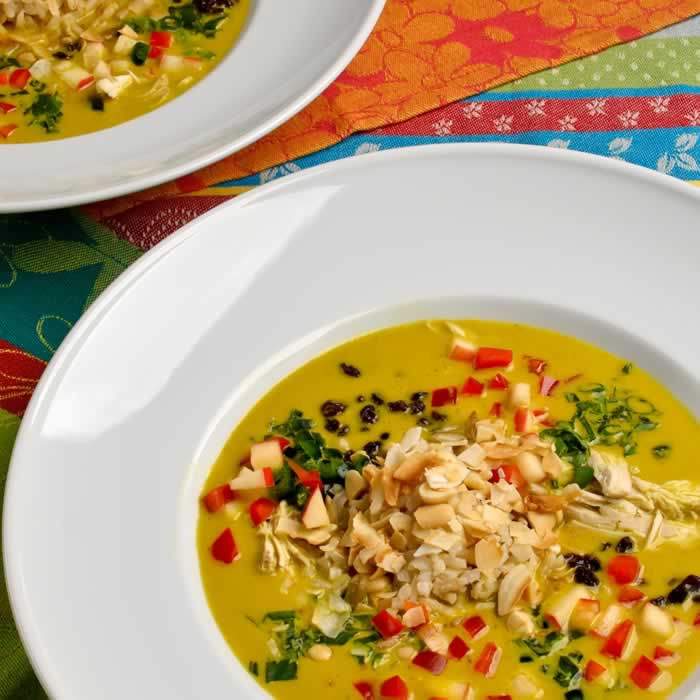A dozen crunchy, spicy, chewy, crispy, salty embellishments delight the palate in this exotically spiced, chile-hot, silky soup.
Do you remember that Seinfeld episode where Elaine and Kramer were kibitzing about Mulligatawny Soup?
Elaine: “Do you need anything?”
Kramer: “Oh, a hot bowl of Mulligatawny would hit the spot.”
Elaine: “Mulligatawny?”
Kramer: “Yeah, it’s an Indian soup. Simmered to perfection by one of the great soup artisans in the modern era.”
Elaine: “Oh. Who, the Soup Nazi?”
Kramer: “He’s not a Nazi. He just happens to be eccentric. You know, most geniuses are.”
I bet that episode sent thousands of people to the web in search of the recipe. The name alone is an inducement. As it happens, the name Mulligatawny derives from what was originally Mullaga (pepper) Thanni (water). In the eighteenth century, during the British Raj in India, Brits inspired its creation by insisting on a soup course, which before that time was not part of Indian cuisine. Then, they brought the concept back to Britain and forgot how to spell it. Okay, I made that last bit up, just to see if you’re paying attention. The spelling “evolved.”
There are so many different recipes for this most English of Indian soups that it was difficult to get a clear sense of the essential elements. Nevertheless, my arduous two hours of research (while simultaneously surfing the web, drinking tea, and watching the food channel) revealed that Mulligatawny Soup frequently consists of chicken stock, sundry veggies, rice or lentils, curry spices, chile pepper, garlic, fresh ginger, and something creamy (coconut milk or cream).
Sometimes it is presented as a silky smooth cream soup and other times chunks of veggies and chicken are bobbing in a creamy base. Mulligatawny Soup can be rather thin or lightly thickened with pureed veggies or flour slurry. Occasionally, tomatoes are part of the mix and lamb may take the place of chicken. (It can also be meat free.) The soup is often enhanced with lentils or rice. It is usually golden yellow, brick orange, or russet red.
But no matter how many recipes for Mulligatawny Soup I encounter on the web and in cookbooks, the version that has a permanent place in my heart is one that was presented at a long ago wedding reception of a good friend and culinary associate.
On a long vegetable-and-herb bedecked table, she presented a silky smooth, lightly thickened, curried soup redolent with fresh ginger, garlic, and garam masala. The aroma was intoxicating. And the entire table was covered with mountains of embellishments: shredded chicken, basmati rice, chopped cilantro, sliced green onions, raisins, toasted coconut, roasted chopped peanuts, roasted sunflower seeds, diced chiles, diced red and green bell peppers, and at least a dozen other goodies. It was simple, yet stunning, and more satisfying and memorable than any grand feast I have experienced since.
Part of the appeal of this soup is surely the do-it-yourself aspect. So, if you plan to wow and entertain your guests, be sure to make a big to-do about the embellishments—the more the better.
Spicy, Creamy Mulligatawny Soup (with Vegetarian Option)
This golden yellow meal-in-a-bowl is as festive as soup gets. A dozen crunchy, spicy, chewy, crispy, salty embellishments compete for attention in this exotically spiced, chile-hot, lightly thickened, silky smooth soup. For simpler meals, you can include only a few embellishments or forgo them altogether. The rice seems essential to me, however.
1 whole chicken, cut into 10 parts (2 breast halves, 2 thighs, 2 legs, 2 wings, 1 back, 1 neck) (makes about 3 cups cooked, shredded chicken)
1 yellow onion, cut into 8 pieces (with skin)
2 large carrots, coarsely chopped
2 large stalks celery, coarsely chopped
2 quarts chicken or vegetable stock
1 quart cold water
3 tablespoons unsalted butter
1 large yellow onion, chopped (3 cups chopped)
1 cup chopped celery
1 cup chopped carrot
2 tablespoons peeled and minced fresh ginger
4 cloves garlic, peeled and minced or pressed
1 serrano chile, stemmed and minced (use disposable gloves)
1 tablespoon LunaCafe Garam Masala (or store-bought curry blend)
1 teaspoon turmeric (skip if using store-bought curry blend that contains turmeric)
8 cups chicken stock from above, plus more if needed
2 cups coconut milk (13.5 ounce can) (Chaokoh brand is good)
fine sea salt, to taste
freshly ground white pepper, to taste
½ cup cream, optional
6-8 wedges of fresh lime
Optional Embellishments
3 cups cooked shredded chicken, from above, heated briefly in a microwave
6 cups cooked brown or basmati rice, heated briefly in a microwave
diced red apple
diced green apple
plump currants or raisins
chopped cilantro
sliced green onions
toasted coconut flakes
roasted chopped peanuts
roasted sunflower seeds
diced poblano chile
diced red bell pepper
- In a large stock or soup pot, arrange the chicken pieces, onion, carrot, and celery. Cover with chicken stock and water, and slowly bring to a simmer. Simmer slowly, partially covered for 30 minutes, replenishing water as it evaporates. Remove from the heat, and let cool for at least an hour or until cool enough to handle the chicken.
- Remove the chicken to a platter and separate the skin and bones from the meat. Tear the meat into small bit-size pieces and reserve.
- Add the skin and bones back to the stock and simmer, partially covered, for an additional hour, replenishing water as it evaporates.
- Strain the stock into a large bowl. You should have at least 8 cups of stock after evaporation. If not, add additional chicken stock. Discard the depleted chicken.
- In a large soup pot, melt the butter and sweat the onions until tender but not browned, about 15 minutes. Add the celery, carrot, ginger, garlic, Serrano chile, Garam Masala, and turmeric and cook for ad additional 5 minutes, stirring a few times in the process.
- Add 8 cups of chicken stock and simmer, partially covered until the celery and carrots are very tender. Add the coconut milk and stir to blend.
- Using an immersion blender, puree the soup. Pour the pureed soup through a triple mesh strainer in a large bowl. Transfer the remaining solids to a blender, add a little of the strained soup and blend until velvet smooth. Add back to the soup.
- Taste the soup for seasoning and adjust with salt and pepper. At this point, the soup may taste a little harsh. It will mellow dramatically if you have time to frig it overnight. If you must proceed, and if necessary to soften the flavor, simmer the soup for another 10 minutes or so. You can also soften the flavor by adding ½ cup of cream.
- To serve, arrange embellishments in small bowls on the dining table. Mound ½ cup cooked, heated rice in the center of each large soup bowl and top with heated shredded chicken. Ladle the hot soup around the rice and chicken, and serve with a wedge of lime. Let guests help themselves to the embellishments.
Makes about 2 quarts, excluding embellishments; serves 6-8.
Spicy, Creamy Vegetarian Mulligatawny Soup
This meatless version is as good as the original, some say even better.
- In Step 1, eliminate the chicken and use vegetable broth instead of chicken broth.
- Skip Step 2.
- Skip Step 3.
- In Step 4, use vegetable broth instead of chicken stock.
- In Step 6, eliminate the chicken.
Resources






The soup looks great! I guess it will make for a fine meal during these cold months. I’ll try this out in the next few days.
On another note, I can agree with Kramer over his remark, “He’s not a Nazi. He just happens to be eccentric. You know, most geniuses are.” It seems to be a truth, once you see the geniuses we have.
I… I want it. I want to eat it. I want to make it. Thank you very much for posting this recipe! Now to make a shopping list…
This soup is SO beautiful. I love the colors. It sounds fantastic too. Bookmarking.
As always, terrific post Susan! I’m very interested in food photography, and your work here is so vibrant and colorful! Very appetizing! I know it’s a bit off topic, but can you share some info about your camera/setup?
Thanks Kevin! While I love to shoot photos at the various farmers markets and do the food styling for most of our shots (I use a handheld Canon Powershot S95 10 MP Digital camera), MauiJim is our official photographer. He carries the BIG camera. I’ve asked him to jump in here and tell you all about his camera and lighting setup.
I’ve asked him to jump in here and tell you all about his camera and lighting setup.
Hi Kevin,
Good food photos result when four elements come together: food, camera, lighting, and post production.
To state the obvious … the food has to be visually appealing. Fortunately for me, Susan’s dishes are perfectly prepared, are made with fresh ingredients, and she uses a wide range of colors and textures to insure the dish is visually appealing. She plates her dishes masterfully (food styling).
The camera has to shoot in Camera RAW. I use a Nikon D7000 and a Canon G11. Both take pictures in camera RAW. Both are good cameras. The key is camera RAW. You also need a good tripod … I went through two cheap tripods … and finally bit the bullet and got a good one.
Good lighting is essential. Natural light is by far the best option. In our case, most of our shots are taken at night, so natural light isn’t available. After wasting countless hours of time and energy trying to work with homemade solutions, I purchased a Lowel EGO Digital Imaging, Tabletop Fluorescent Light Unit … then a second … and finally a professional soft box on a stand.
If you have a visually appealing dish, a camera with RAW, and a good light source, you can get a good shot, and then production becomes relatively easy. Both Canon and Nikon have decent Photoshop-like software included with their cameras. I use both Adobe Photoshop and Lightroom 3. You don’t really need both … Lightroom 3 will do the trick nicely.
The great thing about being a photographer at LunaCafe is that when the shot is done … I get to eat the results. Today we shot a new tortilla soup and it was fabulous.
Best of luck!
MauiJim
This looks delicious, but the recipe doesn’t make any sense! steps 1-4 are fine, but step 5 comes out of nowhere. huh? all you have said is to make the stock. Then all of a sudden there is a soup to puree.
Nancy, thanks for the heads up, much appreciated! Taking a look at it now.
As Nancy pointed out, there were 2 missing steps in the Mulligatawny Soup recipe. Those steps have been reinserted. Now I am going to go fire my editor. Oh wait, that’s me.
I remember making this soup at a restaurant 15 years ago in Portland. I had to make an extra couple of gallons knowing the staff kept sneaking bowls of it throughout their shifts. It was so good and warming, I couldn’t really fault them for taking more than a small bowl so they would know how to describe it to the customers. Funny, I don’t think I have made it since then. Perfect for a cold winter’s day. Thank you for posting. I am off to the store to buy a chicken!
Sasha, which restaurant? We just finished off the last of this soup, and I’m sorry it’s gone even though we’ve eaten it three days in a row. It just kept getting better and better each day.
It just kept getting better and better each day.
Susan! What a wonderful site! A friend just posted your site on Linkedin, and I’m so happy! I’m a personal trainer (NSCA-CPT), integraged wellness coach and holistic Health Counselor (IIN) and I’m always looking for great sources for my clientelle (and me!). I love great and real food!
Keep it up, can’t wait to try the Creamy Mulligatawny Soup, yes!
Carol
Carol, what a lovely note, thank you! P.S. You are going to LOVE this soup!
P.S. You are going to LOVE this soup!